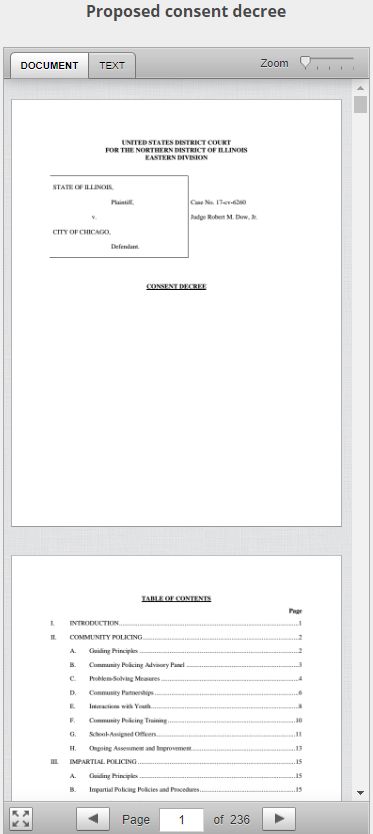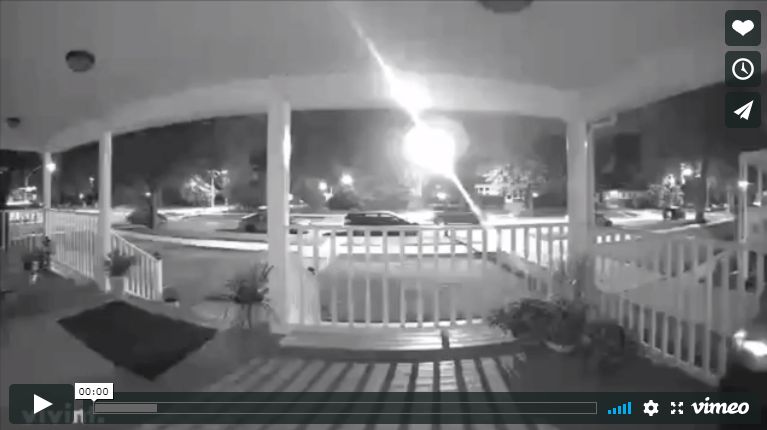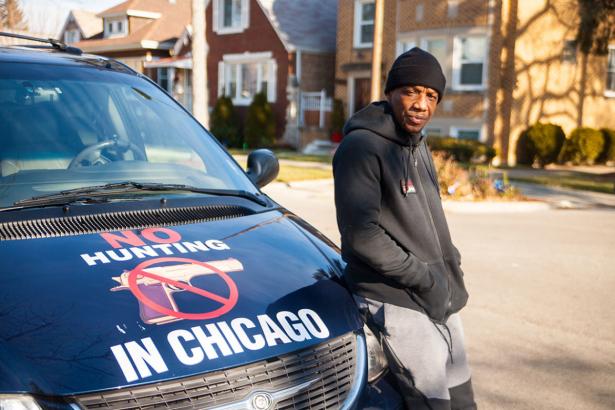For People with Disabilities, Chicago Police Consent Decree Takes First Steps Toward Reform
When Eric J. Wilkins was pulled over by the Chicago police in the spring of 2002, he was on edge.
His older brother was sitting in prison at the time, a victim of Jon Burge-era police torture. And Wilkins, himself, says the police had roughed him up after he had been shot in the back and leg, just three years prior.
The officers who pulled his car over in 2002 told him to get out. Wilkins asked them if he could get his wheelchair from the backseat. The officers, Wilkins says, told him there was no need. And then they picked him up like a baby.
“They just got me out like I was their brat and sat me on the curb,” recalls Wilkins, who now runs the Broken Winggz Foundation for people paralyzed by gunshot wounds. “It made me feel defenseless and angry.”
People with physical or mental disabilities, like Wilkins, are one of the most over-policed groups in the country. They are 44 percent more likely to be arrested by the age of 28 than individuals without disabilities, according to a 2017 Cornell University study.
Humiliations like the one Wilkins describes are common, people with disabilities say, and interactions with the police can quickly become dangerous. A 2016 report by the Ruderman Family Foundation found that a third to a half of all the times police use force involve someone with a disability.
But while policing disproportionately impacts people with disabilities, and despite Chicago’s current process of creating a court-enforceable police reform plan known as a consent decree, local organizers say that their struggles with police abuse have not gotten the attention they deserve.
“We have a police department in this city who really hasn’t paid attention to disabilities,” says Amanda Antholt, senior attorney at Equip for Equality. Antholt helped bring the Communities United lawsuitagainst the City of Chicago last year in an effort to force the government to include community members, include people with disabilities, in the development of the consent decree. The Chicago Reporter is an editorially independent project of the Community Renewal Society, which is party to the lawsuit.
“There’s no tracking of police interactions with people with disabilities and there’s no comprehensive policy for how to recognize and respond to people with disabilities,” says Antholt. “The police still haven’t grappled with the role of disability in their work.”
Consent decree could bring reforms
Part of the challenge for police officers in responding to the issue of disability is the diversity of people with disabilities and the breadth of their experiences and needs.
Nearly 13 percent of the U.S. population has a physical or mental impairment, according to the most recent American Community Survey put out by the Census Bureau. The most common disability is “ambulatory” — having trouble walking or climbing stairs — but disabilities range from people who are deaf or blind to those who are autistic or have developmental disabilities.
The 1990 Americans with Disabilities Act prohibits state and local government from discriminating against people on the basis of their disability. This means that all city services, including the police department, should be accessible to people with disabilities. But accessibility doesn’t just mean ramps on stairs and elevators. It can also mean giving people time and space to communicate or move their bodies when they need it.
“When we talk about disability, yes, we’re diverse and have many identities, but law enforcement lacks an understanding of what that looks like,” says Candace Coleman, a racial justice organizer at Access Living who describes herself as “a black woman with a disability from the South Side of Chicago.”
Coleman has cerebral palsy and sometimes uses a wheelchair to get around. She says that while police using excessive force against people with disabilities is a problem, most of the issues she and others run into are more insidious — like what happened to Wilkins during his traffic stop.
“I’ve been in organizing spaces or actions where there will be a lot of people in one arena, but if [the police officers] don’t ask or don’t understand what my disability type is then I’ll be hoarded with the rest of the group,” putting her safety at risk, says Coleman. “Even when trying to explain what’s going on, there was just no room for being accommodating in those situations.”

Click here to view this document
The proposed police consent decree, which a federal judge is now considering whether to approve, may help address these concerns. According to Access Living, more than 292,000 people in Chicago have a disability of some sort.
The current draft of the decree mentions disability or disabilities 38 times in the 236-page document and outlines plans for increased training and the creation of specialists within the police department to address disability issues.
Currently, Chicago police recruits receive four hours of training on “law enforcement and disabilities” and an additional two hours on autism. Officers are also required to read aspecial order that describes the Americans with Disabilities Act and department procedures in accommodating people with disabilities.
If the consent decree is approved as drafted, the department will be required “to develop a training bulletin that provides CPD members guidance on interactions with people with disabilities” by January 1, 2020. This would include how to effectively communicate with people who are deaf, recognize and respond to behavior that is related to a person’s disability and identify abuse or exploitation of individuals with disabilities.
Additionally, officers will be taught “strategies for establishing and strengthening community partnerships” with people with disabilities and other groups — ranging from religious minorities to women to people of color — in their annual in-service training.
“The consent decree provides a comprehensive framework for addressing CPD’s engagement with individuals with disabilities,” says Eileen Boyce of the Illinois Attorney General’s office, which worked with the mayor’s office to write the consent decree.
But advocates say the consent decree could require more comprehensive training on disability.
“The fact that they’re doing a training bulletin, just a memo, instead of having live training is really a problem,” says Karen Sheley, the director of the American Civil Liberties Union of Illinois’ Police Practices Project.
Wilkins, who also works as an organizer at Communities United, says he would like to see a training led by someone with a disability to encourage empathy.
“Use somebody that’s going through a disability, because not only do they see the [training bulletin], but they see another person with a disability work,” Wilkins says.
Disabilities misinterpreted as non-compliance
The gap between the department’s current training on disabilities and reality was made plain this fall with the release of a 2017 police shooting video and a lawsuit brought against the city by the victim.
In August 2017, 18-year-old Ricardo Hayes snuck out of his house in Morgan Park and was reported missing by his caretaker. Hayes, who has developmental and intellectual disabilities, can be seen wandering around his neighborhood unarmed in a series of videos later released by Chicago’s Civilian Office of Police Accountability.

Click here to view this video. Source: Civilian Office of Police Accountability
That’s when he encountered off-duty police officer Khalil Muhammad. In a statement released that night, CPD wrote that the officer “observed a male subject behaving suspiciously” and that the subject “became elusive and unresponsive” during questioning.
What happened next was caught on a home surveillance camera. Hayes is running away from Muhammad’s pick-up truck and then stops cold in his tracks. He stares at the truck with his hands down at his sides and takes a few steps forward.
Muhammad opens fire, injuring Hayes’ arm and chest. Hayes survived, but has had to be hospitalized multiple times since the shooting.
“Obviously this would be traumatic for anybody, but for somebody [like Hayes] who unfortunately doesn’t have the skill set that they can use because of their special needs to deal with these kind of traumas,” it’s especially bad, says his attorney Gabriel Hardy.
“We know people with disabilities are responding to police officers in different ways [than people who are not disabled] and that police have countered with the use of force,” says Antholt of Equip for Equality. “For example, someone who is deaf might not hear a command, and under traditional approaches an officer would escalate the situation. Similarly, someone who is autistic might take time to respond and someone who is diabetic might move their body in ways the police doesn’t expect,” such as twitching or convulsing.
When faced with someone who seems “elusive and unresponsive,” as in Hayes’ case, or who doesn’t put their hands up or lie down when asked to, officers may assume the person is uncooperative and escalate the situation, Antholt says.
It is unclear how much the training bulletin in the proposed consent decree would have changed how Muhammad responded to the incident, but Hayes’ attorney maintains that the shooting reveals that officers are not getting substantial training on disabilities.
“The City has failed to provide training to the majority of its officers regarding how to recognize developmental disabilities in civilians, and how to interact with such civilians,” reads a lawsuit filed by Hayes’ lawyers against the city in August. “To the extent the City has attempted to train a minority of its officers in interacting with people with mental disability, the training has been inadequate.”
The lawsuit argues that by failing to provide adequate training, the City of Chicago violated the Americans with Disabilities Act and discriminated against Hayes on the basis of his disability. The case is pending in the Northern District of Illinois and the next court date is in late winter.
Alternatives to arrest, calls for help
A 2016 report from the Ruderman Family Foundation found that “up to half of all people killed by the police in the United States are disabled.” Nationally, four in ten of the people in local jails and three in ten people in prison have at least one disability, despite making up just 1 in 10 of the American population.
“Too often people are taken either to the hospital or jail when other services could be provided that would keep the person out of the criminal justice system when it’s not necessary,” the ACLU’s Sheley says.
The consent decree suggests the police department to consider alternatives to arresting or using force against people against the general population by requiring officers to complete an in-person training every three years that would introduce them to local resources for pre- or post-arrest diversion programs and when to use them. It also creates an advisory committee to give the city guidance on developing drop-in centers or mobile crisis teams.
“[Diversion programs] cost less to the state and the city and it would be beneficial to everybody,” Sheley says. While the advisory committee is a positive step, Sheley says, she wishes that the decree required officers to use diversion programs. “ was an ask that we made that we didn’t get.”
The advisory committee created by the consent decree will also explore the creation of a central nonemergency crisis line.
Chicago currently doesn’t have a citywide phone number that someone can call to get non-police help for people having a mental health emergency. When they call 911, a police officer trained in crisis intervention may respond, but that is not guaranteed. Only 20 percent of all CPD officers have completed the department’s weeklong crisis intervention team training, which focuses on de-escalation techniques.
“CPD is continually striving to improve responses in dealing with service calls related to disabled persons and persons in crisis,” CPD spokesman Luis R. Agostini said in an email statement.
But other cities are considering different models entirely, ones that take police officers out of the equation.
In Eugene, Oregon, for example, crisis workers and medics from the nonprofit Cahoots respond to such calls and not police officers. Cahoots currently responds to 17 percent of all calls for service made to the police department there, according to a recent Wall Street Journal article.
‘A restart for the whole city’
One year ago, Wilkins’ employer, Communities United, joined four other organizations in suing the City of Chicago to demand institutionalized police reform that protects the safety and rights of people with disabilities. As part of the city’s efforts to resolve that lawsuit, Mayor Rahm Emanuel and Attorney General Lisa Madigan agreed to include Wilkins and others in drafting the consent decree and to include provisions in the document that would reduce the likelihood that police would use force against people with disabilities.
Over the course of the last year, Wilkins met regularly with staff members from the mayor’s and attorney general’s offices and went through draft after draft negotiating for certain reforms to be included.
“[The proposed consent decree] has a lot of pluses in it,” Wilkins says. “It’s like a restart for the whole city.”
One of those pluses is the creation of an Americans with Disabilities Act liaison within the police department. People with disabilities will be able to reach out to this person with concerns and they will be required to “regularly review the effectiveness and efficiency of CPD’s policies and training as they relate to individuals with disabilities.”
But Wilkins says the decree is only the start of reforms that need to happen in the CPD: “It’s going to be a floor document, so there’s room for everything to grow off of it.”
Access Living’s Coleman says that real change in the police department will require a culture shift. People need to stop “looking at disability as an ‘other’ community, but as a part of our human nature.”
“Especially for people who are doing non-criminal activities, they’re just living their life and doing what they normally would do,” Coleman says.
“We’ve seen cases for people with autism where they’re just stimming,” she adds, referring to behaviors like rocking or spinning that are common with autistic people. “But because police don’t understand what that is, they’ve been harmed for just being what they naturally are.”
This story was produced by City Bureau, a Chicago-based civic journalism lab.
Nissa Rhee covers criminal justice and poverty issues for City Bureau, The Christian Science Monitor and the podcast 70 Million. She is also a co-founder of the immigration storytelling nonprofit, 90 Days, 90 Voices. You can contact her on Twitter at @nissarhee.
About The Chicago Reporter
Founded on the heels of the civil rights movement of the 1960s, The Chicago Reporter confronts racial and economic inequality, using the power of investigative journalism. Our mission is national but grounded in Chicago, one of the most segregated cities in the nation and a bellwether for urban policies.
Subscribe to The Chicago Reporter
Click here to become an e-subscriber to The Chicago Reporter to receive our free newsletter and keep up-to-date with all of our major stories on race, poverty, and income inequality.
The Chicago Reporter, published by the Community Renewal Society, is committed to protecting your privacy. We never share personal information without your consent. View our full privacy policy.


Spread the word